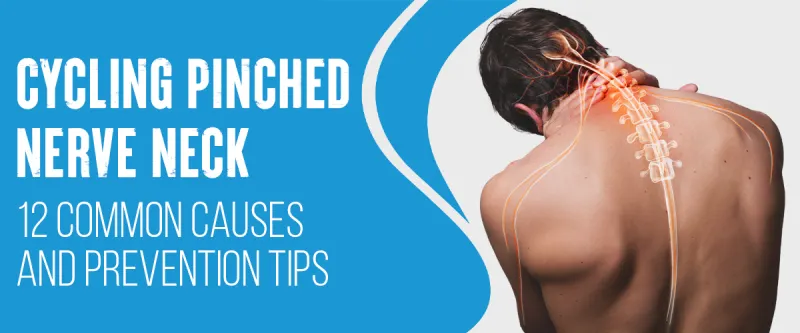The constant movement, strain, and pressure on neck muscles can cause a pinched nerve, causing pain, numbness, and even weakness. Overuse injuries are a common cause of neck pain in cyclists.
Your head is tipped upward when you ride a road bike, which can aggravate arthritis in the neck, pinch nerves, and cause spinal stenosis. Cycling incorrectly can cause neck pain for many people.
In this blog post, we’ll explore the connection between cycling and neck pain, the common causes of pinched nerves, and preventive measures to alleviate discomfort and ride pain-free.
Cycling Pinched Nerve Neck: 12 Common Causes

You can stay fit by cycling outside, but neck pain can result if certain factors are not considered. We’ll explore common neck pain causes cyclists may experience and how they can be prevented.
Overuse Injuries from Repetitive Cycling
Cycling, like any repetitive activity, can strain your neck. Overuse injuries among cyclists often cause neck pain. These injuries occur when you cycle for extended periods without giving your neck the necessary care. Here are some key points to consider:
- Ride in moderation, and don’t overdo it, especially if you’re new to cycling.
- Take breaks during long rides to stretch and relax your neck muscles.
- Pay attention to your riding posture and avoid straining your neck by looking up or down for extended periods.
Poor Bike Fit and Its Impact on Neck Health
A well-fitted bike is essential for a comfortable and pain-free ride. Poor bike fit can contribute to neck pain. Here’s what you should know:
- Ensure your bike is adjusted to your body’s proportions and riding style.
- Consult with a professional bike fitter to ensure an optimal fit.
- Handlebar height, saddle position, and frame size should be considered for a pain-free experience.
The Influence of Helmet and Head Position
Wearing a helmet is crucial for safety, but it can also affect your neck if not used correctly. Here’s what you need to keep in mind:
- Protect your head and neck by wearing a properly fitting helmet.
- Adjust your helmet so it sits level on your head, not too far forward or backward.
- Maintain a neutral head position while riding to reduce strain on your neck.
Muscle Imbalances and Their Contribution
- Incorporate strength and flexibility exercises to maintain muscle balance.
- Focus on your neck and shoulder muscles to prevent imbalances.
- Cross-training with activities like yoga or swimming can help strengthen neglected muscles.
Pinched Nerve In The Neck Can Be Aggravated By Cycling
As passionate cyclists, we thrive on the open road, the wind in our faces, and the freedom of movement that comes with every pedal stroke.
However, amid the exhilaration of cycling, a potential menace lurks that can disrupt our joy. The pinched nerve in the neck. This seemingly innocuous condition can significantly affect our cycling experience.
Headaches Stemming from Pinched Nerves
A pinched nerve in your neck could be the culprit behind those persistent headaches. The pressure exerted on the nerve can trigger discomfort along its pathway, leading to headaches.
If you’re an avid cyclist, the repetitive motion and strain on your neck while cycling could exacerbate this condition.
Cervical Vertigo
Pinched nerves in the neck might be the culprit. This condition, known as Cervical Vertigo or Cervicogenic Dizziness, can mess with your balance, causing frequent bouts of dizziness. This adds another layer of concern for cyclists, especially during rides that demand focus and stability.
Navigating Dizziness Caused by Pinched Nerves
While pinched nerves typically don’t directly induce dizziness, they can indirectly trigger it if in the neck or upper spine.
The pressure exerted on the nerves controlling balance can cause dizzy spells. Cyclists should be mindful of this possibility, especially during longer rides with more pronounced neck strain.
Neck Pinched By Cycling: Symptoms

It’s essential to know the signs and symptoms that could indicate a pinched nerve in your neck while cycling. You can address these symptoms early by addressing the issue and preventing it from worsening.
Pinched nerves in the neck can be uncomfortable and affect your cycling experience. Here are some key indicators to look out for:
- Pain: You may experience sharp, shooting, or dull aches in your neck. You may feel pain radiating down your arms or into your shoulders.
- Tingling or Numbness: You might feel tingling or numbness in your neck, shoulders, or arms. This sensation can come and go or be persistent.
- Muscle Weakness: Pinched nerves can cause muscle weakness in the affected area, making it difficult to maintainareas, making maintaining a firm grip difficult or maintain proper control.
- Decreased Range of Motion: You may find it challenging to turn your head or tilt it in different directions due to restricted movement.
- Radiating Pain: Pain may radiate down your spine, into your upper back, or even into your chest. This can be alarming but is a common symptom of a pinched nerve.
Differentiating Neck Pain from Other Cycling Problems
Cycling can be demanding on your body, and neck pain can sometimes be mistaken for other cycling-related problems. Here’s how to differentiate neck pain from other issues:
- Saddle Soreness: If you feel discomfort primarily in your sit bones or groin area, it’s more likely related to your saddle and bike fit rather than a pinched nerve.
- Back Pain: Pain in your lower back may be a separate issue, often linked to poor posture or bike fit, while neck pain is usually higher and can be distinct.
- General Fatigue: If your pain is more widespread, and you feel overall fatigue, it might be a sign of overexertion rather than a pinched nerve.
- Tight Muscles: Stiff or tight neck muscles can result from tension or poor posture during your ride, but these symptoms should subside with rest and stretching.
Neck Pinched from Cycling: 12 Prevention Tips
Prevention is key to preventing injuries, especially neck injuries. Neck pain and pinched nerves are common cycling injuries, but there are effective preventive measures cyclists can take to avoid experiencing these issues.
Massaging a Pinched Nerve in the Neck
If you’re experiencing a pinched nerve in your neck, effective massage techniques can provide relief and help speed up recovery. Here are some methods you can try:
- Gentle Circular Motions: Use your fingers to apply gentle, circular pressure around the area where you feel the pinch. This can help increase blood flow and reduce muscle tension.
- Stretch and Release: Slowly tilt your head towards each shoulder, holding the stretch for a few seconds, then gently release.
- Heat Application: Apply a warm compress to the affected area before massaging to relax the muscles.
Proper Bike Fit and Its Importance
Every cyclist needs a proper bike fit. Not only does it improve your performance, but it also helps prevent injuries such as neck pain and pinched nerves. When your bike is fitted correctly, it will distribute your weight evenly, reducing the strain on your neck and upper back.
Here are a few things to keep in mind when it comes to proper bike fit:
- Make sure your bike is the correct size for you. This can vary depending on your height, inseam, and other factors.
- Adjust your saddle height so the bottom of your pedal stroke is slightly bent.
- Check your handlebar height and reach to ensure that your upper body is in a comfortable position.
The Role of Stretching and Strengthening Exercises
Strengthening and stretching exercises can reduce neck pain and pinched nerves by improving posture and reducing muscle tension. Some activities that can be helpful for cyclists include:
- Chin tucks: Place your back against a wall, tucking your chin towards your chest. Repeat 10 times for 5 seconds.
- Shoulder blade squeezes: Squeeze your shoulders while standing or sitting. Repeat 10 times for 5 seconds.
- Yoga poses: Yoga improves flexibility and reduces muscle tension. Poses such as downward-facing dog, child’s pose, and cat-cow can benefit cyclists.
Helmet Selection and Adjustment Tips
A helmet is one of the most important safety measures you can take while cycling. Your helmet also plays a role in preventing neck pain and pinched nerves. Here are a few tips for choosing and adjusting your helmet:
- Your helmet should be the correct size and fit snugly on your head. It should not move around or slide forward when you shake your head.
- Ensure that the straps are adjusted correctly. They should form a “V” shape around your ears and not be too tight.
- Adjust the height of your helmet so it is level with your head. It should be about one or two finger-widths above your eyebrows.
Ergonomic Accessories for a Pain-Free Ride
You can use ergonomic accessories to reduce your risk of neck pain and pinched nerves while cycling. Some options to consider include:
- Padded handlebar tape: This can help reduce vibration and provide extra cushioning for your hands and wrists.
- Ergonomic grips: These grips reduce pressure on your hands and wrists, making for a more comfortable ride.
- Raised stem: An expanded branch can help bring your handlebars closer to you, easing strain on your shoulders.
A Pinched Nerve In The Neck: Treatments
The pinched nerve in the neck. This seemingly innocuous condition has the potential to disrupt our cycling adventures, causing discomfort and affecting our performance. Here are some best ways to treat a pinched nerve in the neck:
Self-Care Strategies
- Rest: Cease activities that exacerbate the symptoms, particularly those involving cycling.
- Immobilization: Depending on the nerve’s location, a splint, collar, or brace may be necessary to immobilize the affected area.
Professional Treatment Options
- Physical Therapy: Learn exercises from a physical therapist to strengthen and stretch muscles, alleviating nerve pressure.
- Medications: Nonsteroidal anti-inflammatory drugs (NSAIDs) and certain prescription medicines can help relieve pain and inflammation.
- Corticosteroids: These can be administered orally or via injection to minimize pain and inflammation.
Surgical Intervention
A cervical foraminotomy is a type of surgery that widens the neural foramen, which is where nerve roots exit the spine and spread throughout the body. It can help ease the symptoms of a pinched nerve.
If conservative treatments cannot improve symptoms after several weeks to months, surgery may be required to ease nerve pressure. The surgical approach employed will depend on the location of the affected nerve.
Conclusion
Neck pain is a common issue many cyclists face, and one of its leading causes is a pinched nerve. The good news is that this type of pain is preventable with proper bike fit, posture, stretching, strengthening exercises, and choosing the fitting helmet.
By understanding the anatomy of the cervical spine, recognizing the signs and symptoms of a pinched nerve, and taking the necessary preventive measures, cyclists can achieve optimal neck health and continue to enjoy their passion for cycling. So, let’s commit to a proactive approach to neck health in cycling and ensure neck pain doesn’t slow us down.
FAQs
How Long Do Trapped Nerves In The Neck Last?
According to a 2023 review of research, most people will experience relief within 8-12 weeks from neck pain caused by pinched nerves.
It is possible, however, that nerve damage in more severe cases may not improve, and people may need more significant treatment, such as surgery.
What Does A Pinched Nerve Feel Like In Your Neck?
A person suffering from this condition may experience sharp neck, shoulder, arm, hand, or back pain. It is also possible to experience tingling or numbness. As a result, your arm may become weak. Symptoms may worsen when you turn your head, cough, or sneeze.



